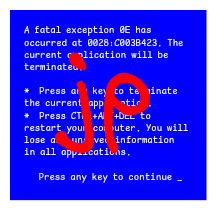I’m sorry Timmy but you’re not allowed to have any dessert unless you close your tags like I taught you. Your grandmother was XMLish and you need to carry on our family tradition.
I thought you might do something like this so I got you a backup one from AO3.
found the react dev
Take that back!
(I’m actually a DB specialist but I have done a lot of full stack work in different portions of my career)
🤓 ackshually that’s not the HTML spec. Void elements should not have trailing slashes.
https://developer.mozilla.org/en-US/docs/Glossary/Void_element
TIL. Funny thing, though, is that they give an example of how to use
<br>and have it with trailing slashes. And then explain that trailing or preceding slash will be ignored, anyway ¯\_(ツ)_/¯> Clicks on
<br>
> Example is<br />
The actual thing that matters is that the
/is ignored so (unlike with XML I believe) you can’t self-close a non-void element by adding a trailing/. But “void elements should not have trailing slashes” is extrapolation on your part; the trailing slash improves readability and is kosher since it doesn’t act as a self-close.Trailing slash lets you do this though:
For example, in the case of
<div/>Some text, browsers interpret this as<div>Some text</div>, treating the slash as ignored and considering the div element to encapsulate the text that follows.Why would you want that.
This is terrible.
You should never rely on a browser interpreting a non standard use in a specific way. It can change at any moment, and wouldn’t be reliably reversed because it’s inherently non standard.
Wasn’t the space before the closing
/only because IE was dumb?An explanation of this problem can be found on the official W3C HTML validator wiki.
HTML parsers only allow this to stop pages breaking when developers make mistakes; see this Computerphile video. ‘Able to be parsed correctly’ is not the soul criterion for it a syntax being preferred, otherwise we would all leave our
<p>elements unclosed.Yes, it is not “incorrect” to write
<br/>, but it is widely considered bad practice. For one, it makes it inconsistent with XML. Linters will often even “correct” this for you.I personally find the official style (
<br>) to be more readable, but this is a matter of personal opinion. Oh, and I used to have the same stance as you, but I also used to think that Python’s whitespace-based syntax was superior…At the end of the day, regardless of anyone’s opinion, we should come to SOME consensus…and considering that W3C already endorses
<br>, we should use this style.If a spec tells me I should do something that makes my code less readable in my opinion I am going to ignore the spec every time.
There’s even one in English that I actively and pointedly flout: punctuation must go inside of the quotes if the quote terminates the sentence
Yeah, unless it’s a formal setting, reader comprehension comes before all else
“readability” is subjective. much like how there is no objective definition of “clean code”. i am not arguing that either option is more generally “readable”, i am insisting that people use a common standard regardless of your opinion on it. a bad convention is better than no convention. i dont personally like a lot of syntax conventions in languages, whether that be non-4-space indenting, curly braces on a new line, or early-declared variables. but i follow these conventions for the sake of consistency within a codebase or language, simplicity on linter/formatter choice, and not muddling up the diffs for every file.
if you want to use
<br/>in a personal codebase, no-one is stopping you. i personally used to override every formatter to use 2-space indenting for example. but know that there is an official best practice, which you are not following. if you work in a shared codebase then PLEASE just follow whatever convention they have decided on, for the sake of everyone’s sanity.if you work in a shared codebase then PLEASE just follow whatever convention they have decided on, for the sake of everyone’s sanity.
That goes without saying; I’m not a barbarian.
“readability” is subjective. much like how there is no objective definition of “clean code”.
Did you not see the part where I said it’s less readable “in my opinion”?
i am insisting that people use a common standard regardless of your opinion on it.
I can read this one of two ways: either you’re making an assertion about what people are currently doing, or you’re telling me/others what to do. In the first case, you’re wrong. I’ve seen many examples of self-closed <br> tags in the open source projects I’ve contributed to and/or read through. In the second case, IDGAF about your opinion. When I contribute to an existing project I’ll do what they do, but if I’m the lead engineer starting a new project I’ll do what I think is the most readable unless the team overwhelmingly opposes me, ‘standards’ be damned, your opinion be damned.
The spec says self-closing is “unnecessary and has no effect of any kind” and “should be used only with caution”. That does not constitute a specification nor a standard - it’s a recommendation. And I don’t find that compelling. I’m not going to be a prima donna. I’m not going to force my opinions on a project I’m contributing to or a team I’m working with, but if I’m the one setting the standards for a project, I’m going to choose the ones that make the most sense to me.
It’s not extrapolation on my part, the HTML spec is pretty direct about it:
- Then, if the element is one of the void elements, or if the element is a foreign element, then there may be a single U+002F SOLIDUS character (/), which on foreign elements marks the start tag as self-closing. On void elements, it does not mark the start tag as self-closing but instead is unnecessary and has no effect of any kind. For such void elements, it should be used only with caution — especially since, if directly preceded by an unquoted attribute value, it becomes part of the attribute value rather than being discarded by the parser.
https://html.spec.whatwg.org/multipage/syntax.html#start-tags
I don’t think it’s an extrapolation to say that code which is “unnecessary and has no effect of any kind” should be omitted.
And yeah, I linked the MDN docs because they’re easier to read but if they disagree then obviously the spec is the correct one.
To be annoyingly nitpicky, how is “unnecessary” defined in this context? Whitespace is usually “unnecessary” but I quite like it for readability.
I broadly agree with you though, the W3C spec changes things.
It’s XHTML, isn’t it?
It’s actually more confusing/less correct to close bodyless elements in HTML. Since HTML treats “/>” the same way as “>” which could lead to a “/>” tag not actually being closed, if it is used on a non-selfclosing tag.
The one on the right should be labeled “full-stack dev” because that’s like 80% of them and they write in C# and Angular 😂
In my own HTML-inspired text format (ETML - embedded text markup language),
<br />can be formatted to have as much space as you need.Need some padding between elements?
Haha nbsp; go brrrrrrrr
I too use
elements go <br>
<br>
actually:
<br>but only sometimes.

 go <br>
( ( laughs in old… ) )
This made my eye twitch
I feel seen…
Oh boy.
We had a class in the first semester of uni where we had to create a static html page based on a screenshot.
There was this one textbox at the top of the site, where the only way you could recreate the screenshot was by using a
<br/>in the middle of the text.The prof was very picky about your HTML being semantically thorough and correct, so that was super weird that that was necessary.
<img>tag harr harrA break is absolutely correct html though.
My point is sematics.
You can style your whole webpage with divs, but using main, nav, footer or whatever blocks is semantically more correct, because you group elements together that have a certain purpose.
A HTML Tag in the middle of a sentence is not wrong per se, but when parsing it a line break could signify two sentences where one has missing punctuation, instead of a complete sentence as your original intention was.
I don’t really care how the design you want is achieved to be honest, but I don’t get why the prof didn’t argue against.
If it’s stupid, and it works…
<br> <br> <br> <br> <br> <br> <br> <br> <br> <br>Fairly straightforward breakdancing.
Or just break stepping.













